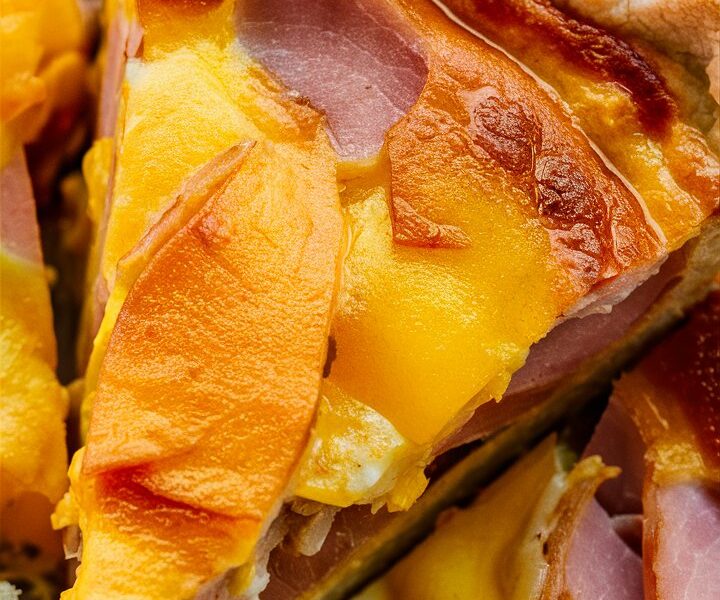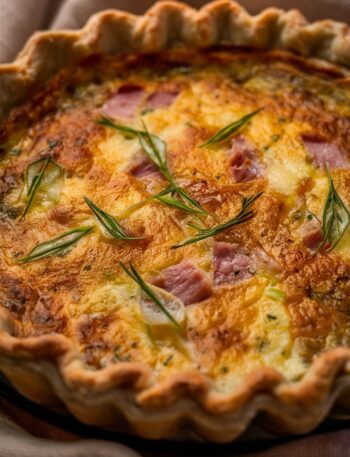Few dishes carry the charm, tradition, and heartiness of Pizza Rustica, also known as Pizzagaina or Torta Pasqualina. This rustic Italian Easter pie is not a pizza in the modern sense, but rather a deeply savory, rich, and festive dish. Wrapped in a flaky crust and filled with layers of creamy ricotta, flavorful cured meats, and a variety of cheeses, Pizza Rustica is a celebratory meal that has traveled across generations and oceans, finding a place on tables from Naples to New York.
Unlike many holiday dishes that are reserved for a single feast, Pizza Rustica works beautifully for brunches, festive dinners, and family gatherings year-round. It is as much a story of cultural heritage as it is a recipe — one that combines Italian ingenuity, seasonal abundance, and the joy of sharing food.
In this guide, we will dive deep into its history, ingredients, preparation methods, and countless variations. By the end, you’ll have everything you need to master Pizza Rustica and perhaps even start your own tradition around it.
The Origins of Pizza Rustica
A Dish Rooted in Celebration
Pizza Rustica has its roots in Southern Italy, particularly in regions such as Campania, Abruzzo, and Calabria. It is most commonly associated with Easter celebrations, marking the end of Lent — a period of fasting and simplicity. After forty days of abstaining from rich foods like meat, cheese, and eggs, Italians would celebrate Easter with dishes that overflowed with abundance.
Eggs became a symbol of rebirth and new life, while meats and cheeses symbolized prosperity. Wrapping these ingredients in a pie was not only practical but also symbolic: the golden crust represented the sun, warmth, and hope of spring.
Regional Differences
- Neapolitan Pizza Rustica (Pizzagaina): Typically filled with ricotta, mozzarella, prosciutto, salami, and hard-boiled eggs.
- Calabrian Style: Spicier, often including nduja (spreadable salami) or hot soppressata.
- Sicilian Torta Pasqualina: Sometimes incorporates greens like spinach or Swiss chard, closer to a quiche-like consistency.
- Abruzzo and Molise: Known for very hearty versions packed with pork and multiple cheeses.
Italian-American Adaptation
When Italian immigrants came to the United States, they brought Pizza Rustica with them, adapting it with the cured meats and cheeses available locally. Over time, it became a staple of Italian-American Easter celebrations, especially in New Jersey, New York, and Philadelphia, where Italian bakeries still sell it during the spring holidays.
Why Pizza Rustica Has Stood the Test of Time
Pizza Rustica is more than just food — it is a reflection of Italian values: family, tradition, and celebration. Its enduring popularity comes from several qualities:
- Hearty and Filling: A slice can serve as a full meal, thanks to its rich filling of protein, fat, and carbs.
- Perfect for Celebrations: Its grandeur makes it a showpiece on a holiday table.
- Flexible: Families adapt it based on regional traditions, seasonal availability, or personal taste.
- Delicious Hot or Cold: It tastes wonderful fresh from the oven or chilled the next day, making it ideal for leftovers.
- Tradition Across Generations: Passed down through grandmothers and mothers, each recipe is a story of heritage.
Essential Ingredients
The magic of Pizza Rustica lies in the combination of simple yet flavorful ingredients.
Ricotta Cheese
- Forms the creamy base of the filling.
- Fresh ricotta works best because it is lighter and less watery.
- Tip: Drain ricotta overnight in a cheesecloth for a firmer texture.
Pecorino Romano or Parmigiano-Reggiano
- Adds sharp, salty depth.
- Aged cheeses balance the creaminess of ricotta.
Mozzarella or Provolone
- Provides the melty, stringy texture.
- Provolone adds a nuttier, sharper flavor.
Italian Cured Meats
- Common choices: prosciutto, salami, soppressata, pancetta.
- Each brings a unique salty, savory note.
- Dice evenly for balanced bites.
Eggs
- Eggs are the backbone of the filling, binding everything together.
- They symbolize new life, reinforcing the Easter connection.
The Crust
- Traditionally made with flour, butter, eggs, and water.
- Can be substituted with store-bought pie crust or even puff pastry.
- The crust must be sturdy enough to hold the rich filling.
Seasonings
- Black pepper, parsley, or a touch of nutmeg for warmth.
- Keep it simple to let the cheeses and meats shine.
Step-by-Step Recipe: Giada’s Inspired Pizza Rustica
Here’s a detailed guide to making Pizza Rustica at home.
Step 1: Prepare the Dough
- Combine flour, cold butter, eggs, and salt.
- Pulse in a food processor until crumbly.
- Add water gradually until the dough comes together.
- Chill for at least 30 minutes.
Step 2: Make the Filling
- In a large bowl, mix ricotta, pecorino, mozzarella, and eggs until smooth.
- Stir in diced salami, prosciutto, and soppressata.
- Season with pepper.
Step 3: Assemble
- Roll out half the dough and line a greased springform pan.
- Add filling and smooth the top.
- Roll out remaining dough and place on top.
- Seal edges and cut small vents for steam.
- Brush with egg wash.
Step 4: Bake
- Bake at 375°F (190°C) for 60–75 minutes.
- Cover with foil if browning too quickly.
Step 5: Cool and Serve
- Let cool for at least 30–45 minutes.
- Slice carefully and serve warm or chilled.
Pro Tips for Success
- Drain ricotta overnight to avoid a watery filling.
- Dice meats and cheeses evenly so every bite has balanced flavor.
- Don’t overfill the pie, or it may spill during baking.
- Use a springform pan for easy serving and professional presentation.
- Let cool before slicing for neat, clean pieces.
Variations and Adaptations
Lighter Options
- Swap pork meats for turkey or chicken sausage.
- Use low-fat ricotta or part-skim mozzarella.
Vegetarian
- Replace meats with sautéed spinach, mushrooms, or roasted peppers.
- Add olives or artichokes for Mediterranean flair.
Alternative Crusts
- Puff pastry for a lighter, flakier version.
- Phyllo dough for a crisp, layered texture.
- Gluten-free flour blends for dietary needs.
Modern Twists
- Mini Pizza Rustica muffins for brunch buffets.
- Layered “slab pie” versions for parties.
- Fusion: add spices like smoked paprika or sun-dried tomatoes.
What to Serve with Pizza Rustica
- Light Salad: Arugula with lemon vinaigrette.
- Vegetables: Roasted asparagus, broccoli, or zucchini.
- Appetizers: Italian olives, marinated artichokes, antipasto platter.
- Drinks: Red wine like Chianti, or a crisp sparkling Prosecco.
- Desserts: Biscotti, tiramisu, or panna cotta.
Storage and Leftovers
- Refrigerate: Store in an airtight container for 4–5 days.
- Freeze: Freeze slices individually for up to 2 months.
- Reheat: Warm at 325°F until heated through.
- Best Served: Tastes even better the next day, after flavors meld.
FAQs About Pizza Rustica
Is Pizza Rustica the same as Pizzagaina?
Yes — both refer to the same Easter pie, though names vary by region.
Can I make it ahead of time?
Yes! It tastes better after resting overnight.
Can I use store-bought crust?
Absolutely. Choose deep-dish pie crusts or puff pastry for convenience.
What’s the best pan to use?
A springform pan ensures easy removal and neat slices.
Can I make a smaller version?
Yes — halve the filling and bake in a standard pie pan.
Is there a vegetarian version?
Yes — swap meats for roasted vegetables and extra cheeses.
Pizza Rustica Beyond Italy
Pizza Rustica has found a home on Easter tables worldwide. In the United States, Italian bakeries sell it each spring, often alongside other holiday specialties like pastiera (a sweet ricotta pie). Families gather around it not only for its taste but also because it serves as a culinary bridge between generations.
Across the globe, variations reflect local tastes: some include smoked meats, others swap in local cheeses, and some even reinterpret it as a quiche-like tart. Yet the spirit remains the same: abundance, joy, and tradition.
Final Thoughts
Pizza Rustica is more than just a recipe — it is a slice of Italian heritage baked into a golden crust. Whether you enjoy it warm at Easter brunch, chilled the next day with salad, or as part of a family feast, it delivers satisfaction and comfort in every bite.
By making Pizza Rustica, you are not only preparing food but also carrying forward a centuries-old tradition of celebration, family, and flavor. Now it’s your turn to bring this rustic pie to your table and make it part of your own story.





